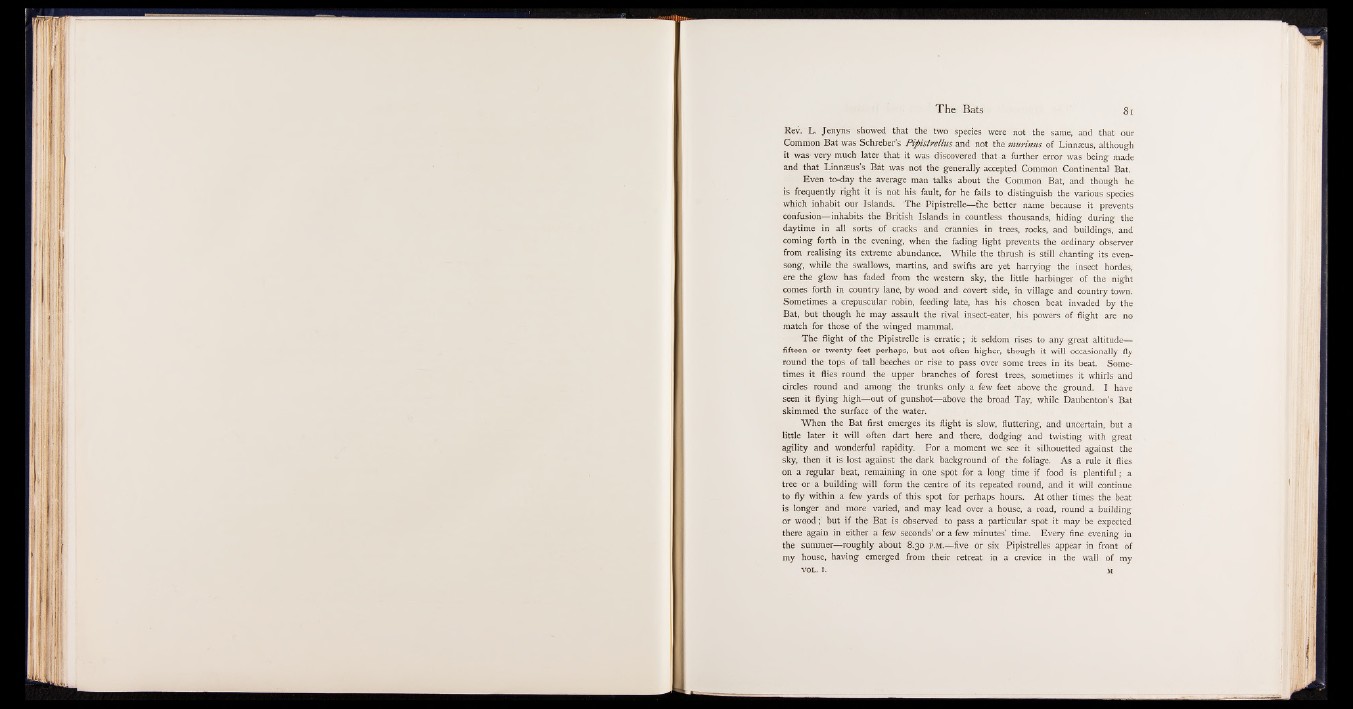
The Bats
Rev. L. Jenyns showed that the two species were not the same, and that our
Common Bat was Schreber’s Pipistrellus and not the murinus of Linnzeus, although
it was very much later that it was discovered that a further error was being made
and that Linnaeus’s Bat was not the generally accepted Common Continental Bat.
Even to-day the average man talks about the Common Bat, and though he
is frequently right it is not his fault, for he fails to. distinguish the various species
which inhabit our Islands. The Pipistrelle— the better name because it prevents
confusion— inhabits the British Islands in countless thousands, hiding during the
daytime in all sorts of cracks and crannies in trees, rocks, and buildings, and
coming forth in the evening, when the fading light prevents, the ordinary observer
from realising its extreme abundance. While the thrush is still chanting its evensong,
while the swallows, martins, and swifts are yet harrying the insect hordes,
ere the glow has faded from the western sky, the little harbinger of the night
comes forth in country lane, by wood and covert side, in village and country town.
Sometimes a crepuscular robin, feeding late, has his chosen beat invaded by the
Bat, but though he may assault the rival insect-eater, his powers of flight are no
match for those of the winged mammal.
The flight of the Pipistrelle is erratic; it seldom rises to any great altitude—
fifteen or twenty feet perhaps, but not often higher, though it will occasionally fly
round the tops of tall beeches or rise to pass over some trees in its beat. Sometimes
it flies round the upper branches of forest trees, sometimes it whirls and
circles round and among the trunks only a few feet above the ground. I have
seen it flying high— out of gunshot— above the broad Tay, while Daubenton’s Bat
skimmed the surface of the water.
When the Bat first emerges its flight is slow, fluttering, and uncertain, but a
little later it will often dart here and there, dodging and twisting with great
agility and wonderful rapidity. For a moment we see it silhouetted against the
sky, then it is lost against the dark background of the foliage. As a rule it flies
on a regular beat, remaining in one spot for a long time if food is plentiful; a
tree or a building will form the centre of its repeated round, and it will continue
to fly within a few yards of this spot for perhaps hours. At other times the beat
is longer and more varied, and may lead over a house, a road, round a building
or wood; but if the Bat is observed to pass a particular spot it may be expected
there again in either a few seconds’ or a few minutes’ time. Every fine evening in
the summer— roughly about 8.30 p.m.— five or six Pipistrelles appear in front of
my house, having emerged from their retreat in a crevice in the wall of my
vol. 1. m